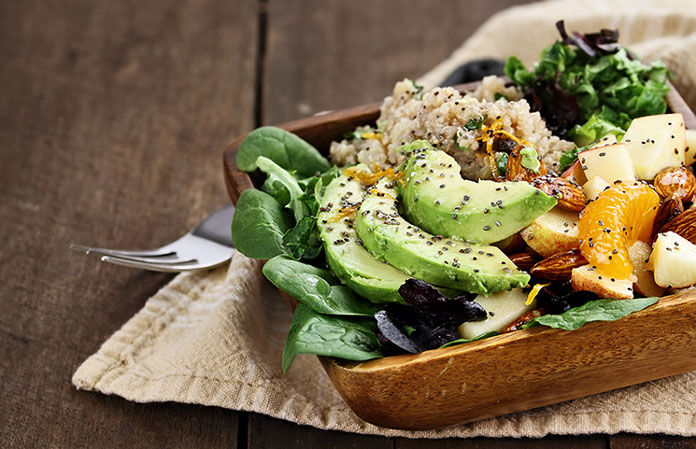Are you wondering how to reduce the portion sizes of food without going hungry? Don’t worry, here are several techniques you can apply to reduce calories while keeping hunger at bay.
8 Tips To Reduce Food Portions Without Being Hungry!
1. Make Sure Veggies Occupy At Least Half of Your Plate
All kinds of vegetables play a very important role in human nutrition. Vegetables contain lots of nutrition and fiber, but just a few calories.
This will help you to eat the same size of meal and still slash calories. You can achieve this by substituting half of either the starch or the protein on your plate with vegetables that contain a moderate amount of carbohydrates and calories.
A recent study on food and nutrition shows that the portion or size of the food you eat is a big factor in feeling full. In fact, in an experiment, each participant was provided with the same amount or size of pasta with various amounts of different vegetables. All the participants in the said experiment ate equal amounts of food regardless of how many vegetables they received. This means that those with the greatest proportions of vegetables ate the fewest calories without knowing it.
Now, it's your turn: Try measuring the size of other foods that you eat and fill the space of your eating plate with vegetables. You can start doing this now and every time you make mixed menus and dishes. Simply add more vegetables to all of your favorite recipes to reduce calories and to have a more nutrient-dense meal.

2. More Protein, More Fun
Proteins consist of one or more amino acid chains. It performs a wide array of functions within human organisms, metabolism, DNA replication, and transporting molecules from location to location.
Science has frequently shown that protein improves human's feelings of being full sp than carbs and fats. A study from 2012 examined the possible effects of eating high-protein snacks on feelings of fullness. All the contributors ate meals with just 20% to 30% of calories from protein. The result of the research stated that those who ate protein-rich foods felt fuller than they did when their meals contained half as much protein.
Now, it's your turn: Fill sections of your plate in every single meal and snack with food rich in protein. The best sources of protein are eggs, skinless chicken, dairy products, seafood, and fish. Proteins that are plant-based are also a good choice. These include beans and bean dips, nut butter, and tofu.
Here are portion control ideas for you to get protein boosted meals and snacks:
- Include some plain yogurt to your everyday breakfast.
- Remember that whole-grain crackers and string cheese are great pairs.
- Poach an egg or two in your vegetable soup.
- Add any kind of beans or a hard-boiled egg to your salad.
3. Include Water In Your Meal
Always remember this, the amount of water you drink every day plays a very important role in sustaining a healthy body.
Juice or sodas are beverages that are rich in calories. Drinking this kind of refreshments doesn't make you feel full. However, it leaves you with additional calories that your body doesn’t need. According to research, when you drink a glass of water right before a meal, they will automatically feel fuller. Because of this, it can reduce the likelihood that you will overeat.
A study concerning older adults shows that people who always drank about 2 cups or 500 ml of water right before their breakfast ate about 13% less than the people who did not drink any water before they ate. In the meantime, researchers also claim that drinking water before every meal doesn’t seem to have the same effect for younger adults.
This means that people ages 18 to 35 years old may or may not have the same reaction to this method of proportion control. Nevertheless, replacing juice or soda with water can really save you calories intake.
Now, it's your turn: Before every meal, try drinking water or other non-calorie beverages. Aside from reducing the proportion of your food intake, it may also quench your dehydration and thirst without doubling the calories.
4. Start With A Vegetable Soup Or Salad
Starting your meal with a vegetable soup or salad can help you to cut your calorie intake. Beginning with a vegetable or any low-calorie ingredient soup or salad takes the edge off of your hunger, leading you to eat smaller portion sizes.
In a conducted study, all participants ate lunch once every week for five weeks in a lab. If they were given a low-calorie soup before the main entrée, the participants ate 20% fewer calories for their whole meal compared to when they ate the main entrée directly. The same group of researchers also found similar results when they gave participants salad before the main entrée in a meal.
Vegetable soups or any soup with low-calorie ingredients and salads both have high water content. Both are also fiber-rich and are very low in calories. A combination of this portion control and the “drinking water before meals” strategy is a great way to reduce your total calorie intake. However, always check out your salad dressing when eating a salad. It can quickly raise the calorie count.
Now, it's your turn: Prepare a vegetable soup or a salad before your meals. Measure your calorie intake and see if the portion size is changed.
5. Use Smaller Plates And Utensils
It might sound unusual, but believe it or not, the size of the plates and utensils can affect the measure of what you eat.
Researchers from one study found out that citizens tend to fill their plates about 70% full regardless of the plate size. That explains why you will eat more food if your plate is a 10-inch plate rather than an 8-inch plate. According to the research, that would be 52% more food.
In another study, a group of people served themselves a bigger amount of ice cream when using a bigger spoon to scoop and ate less ice cream when using a smaller spoon. So, it just proves that using smaller plates and utensils is a quick and easy way t lower the amount that you eat.
Now, it's your turn: Try to eat on a very small plate and use 1 fork only, meaning no spoon at all. Record your calorie intake for a week.
6. Eat Mindfully
Eating while holding and using your smart phone or watching TV can distract your eating process. According to studies, distracted eating leads you to intake more and more.
Mindful eating helps you notice your fullness more immediately. Eating while paying full attention to the food that you are eating and without any distractions can actually give you the hint that you’ve had enough significantly faster. It can also help you distinguish what you feel between physical and emotional hunger.
Now, it's your turn: Once you feel that you are hungry, ask first yourself if you’re really hungry or if you’re just bored or undergoing another emotion. If you think you are in the custom of emotional eating, try to do some other activities before eating. This strategy may include going for a short hike, exercising, or having a mug of tea while reading a book.
7. Make Your Meals Spicy
Did you know that adding hot chili peppers to your food can help you reduce your intake?
Hot peppers and chili peppers have a compound called capsaicin, which can help people reduce their appetite as well as hunger. A study shows that people who consumed hot red peppers as a portion of their appetizer ate 190 fewer calories compared to those people who skipped the spice. If you happen to not be a fan of spicy food, you may consider ginger instead as it may have a comparable effect.
Now, it's your turn: Try to drink ginger tea every day during your breakfast for at least a week. If you don't like the taste of ginger, you may want to create and appetizer-like food and put chili pepper in it. This will reduce your food intake and that you will continuously help with size and proportion control.

8. Soluble Fiber Foods Are Good
Foods that are fiber-rich can help you feel full, according to research.
Meanwhile, foods that contain soluble fiber are particularly filling because it holds more water. Foods that are soluble fiber-rich include oatmeal, pears, legumes, beans, sweet potatoes, and so much more. Foods that are rich in soluble fiber produce a solid and concentrated gel that helps humans to have slow digestion and keeping hunger at bay.
A recent study found that adding ingredients that are rich in soluble fiber like flax or chia seeds to a meal plan increases feelings of fullness. The researchers also found that eating seeds reduced the hunger hormone ghrelin after the end of a six-month period.
Now, it's your turn: Here are some easy techniques to increase your soluble fiber consumption every day.
- Add chia seeds to your breakfast. If not available, add ground flax seeds.
- Top your oatmeal with minced or diced apple or pear for a high fiber breakfast bowl.
- Put beans into your soups, salads, and other foods.
- Eat more winter and summer squash.
- They are really high in soluble fiber.
- Make fruit your most common snack.
Lowering Food Portions Without Being Hungry Conclusion
Reduce eating foods that are high in calories, but remember that you don’t have to feel hungry. Remember that there are many paths to take to help with portion control.









